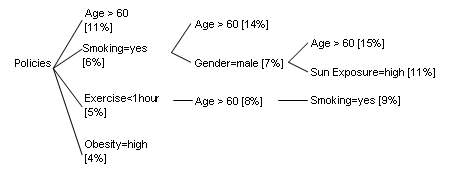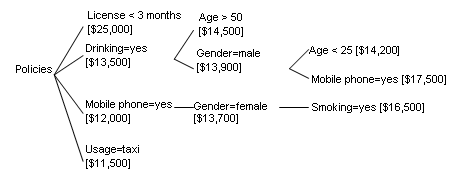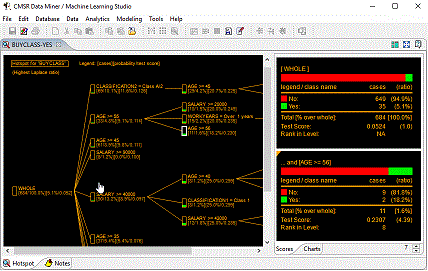Profiling
By The Macquarie Dictionary, profiling is "outlining of something seen against a background".
Profiles can be developed for human populations, animals, and inanimate objects such as products
and parts. Profiling has been used for various purposes. Profiles provide summarized views
on study groups. Especially, profiling has been extensively used in describing human populations
for various purposes.
The following list explains some of special cases of profiling activities on human population;
-
Demographic Profiling describes characteristics of populations in terms of
demographic variables such as age, gender, race, education, occupation, income, religion,
marital status, family size, children, home ownership, socioeconomic status, and so on.
-
Psychographic Profiling describes characteristics of populations in terms of
psychographic variables such as life style, personality, values, attitudes,
and so on.
-
Racial Profiling describes characteristics of populations in terms of
racial and ethnic background. Often mis-used by law enforcement agencies.
-
Criminal Profiling describes characteristics of criminals.
-
Geographic Profiling describes characteristics of geographic profiles
in locating criminals.
-
Customer Profiling describes characteristics
of customers.
Combinational Factor Analysis and Combinatorial Blowout!
It is important to note that profiling is often performed on data with
the following properties;
- profiling information can consist of many variables (dozens or hundreds of them).
- majority of them are categorical variables (or non-numeric variables or
nominal variables).
In conventional profiling methods, analysts use visualization and statistical
reporting tools. These tools can work on only a few variables at a time.
When applied to data with many variables like this, the numbers of cases
to be examined grow combinatorially to the numbers of variables.
Therefore, thorough systematic accurate analysis of such data is all but
impossible. General practice is to examine only variable combinations
what experts think promising. However, intuition can omit
important trends and patterns emerging. Better ways are needed for timely thorough
systematic analysis!
|
Hotspot Profiling
Hotspot Profiling Analysis can search hotspot profiles systematically
from a given set of demographic, geographic, and psychographic variables.
It generates accurate profiles based on Artificial Intelligence Search &
Incremental Learning techniques.
Hotspot search can be based on various performance criteria depending on the types
of target variables;
- Categorical information: probability, Laplace, goodness of fit, entropy, etc.
- Numerical information: average, total, harmonic ratio, etc.
Generalized Profiling
In business, customer profiling is very important in conducting business.
This information provides overall patterns about customers and can play
vital role in developing overall marketing strategies.
[Example 1]
A company that sells boutique products may develop profiles of customers as follows.
Intuitively, most customers are females (91%). Majority of customers work
as office worker (78%). Note that office workers have more needs to use beauty
products! And so on. This information can be used in selecting magazines or
TV and Radio programs for advertisement.
| Gender=Female |
91% |
| Vocation=Office worker |
78% |
| Education=High school |
67% |
| Age=20s |
36% |
| Age=30s |
31% |
Focus Group Profiling
Developing profiles of special focused groups are much harder than that of
generalized profiles, especially with many variables. Hotspot analysis can develop
focused group profiles very effectively with accuracy.
In insurance industry, profiling is very important in determining premium rates.
Typically, insurers collect every information available. However, analyzing thoroughly
is not feasible since the number of variables is normally large. The following two
examples demonstrate how hotspot analysis can be used in profiling risky insurance
policies out of dozens of customer variables;
[Example 2]
An insurance company keeps health insurance or
life insurance records in its database:
gender, age, education, smoking, drinking, sun activity, height, weight (=obesity level),
claim payment, etc., as well as contact information.
The company wishes to know which health insurance groups are at the highest risk,
i.e., have the highest claim ratio. The following is a possible
output of hotspot analysis;

[Example 3]
An insurance company keeps records on motor vehicle insurance or
automobile insurance
information in its database containing
driver and vehicle information together: Gender, age, license experience, education,
occupation, drinking, smoking, mobile phone use; vehicle manufacturer, type, model,
year make, etc. The company wishes to know which motor vehicle insurance is at the
highest risk groups, i.e., highest average insurance payouts. The following is a
possible output of hotspot analysis;

To know more this, click Insurance Risk Analysis.
The following figure shows an example of hotspot analysis output. Top-left is hotspot
drill-down tree. Top-right shows detailed statistics of hotspots selected.
Bottom left and right provide gains/lift factor analysis.

For more information on Hotspot Analysis, click here.
Thorough Systematic Accurate Analysis
The benefit that hotspot analysis provides is that profiling through thorough systematic
accurate analysis is possible instantaneously. This frees analysts from time-consuming
statistical analysis processes and allows them to focus on interpretation of
hotspot profiles identified.
Data Mining Tools for Profiling
It is noted that the content of this page is largely based on
CMSR Data Miner tools. For more, read
CMSR Data Mining Software.
|
|



